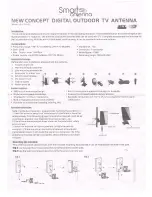
Tech Support:
www.steppir.com/support
Tel: 425.891.6134
Page 57
CHAPTER EIGHT
SECTION 8.5
MAST PLATE AND DOUBLE TRUSS (continued)
PHILLYSTRAN TRUSS ASSEMBLY (continued)
The Phillystran truss material used for the DB42 truss is the HPTG 2100I, which has a break strength of
2100 lb. This material is 0.22 inch OD, and is an ideal truss material. When installing the Phillystran on
the DB42 Yagi, you will want to start from the truss attachment plates on the outside ends of the boom
first, and then complete the process by attaching the other end to eyebolts located on the truss mast
boom.
Locate the two identical truss attachment plates (PN 10-1607-11). These will be used along with two 2
inch aluminum saddle halves (PN 10-1601-22), two 5/16” x 3.50” hex head bolt (PN 60-0065), and two
5/16” Nylock nuts (PN 60-0046).
Figure 8.56
shows the configuration of the parts used for this assem-
bly.
You will have already marked the placement of the saddles in chapter one. The placement of the truss
attachment plates are located in between the two boom bolts that hold the 2” and 1.75” sections of the
boom together as shown in
figure 8.57
. The boom is double walled at this point of attachment, which
limits flexing of the boom under loading situations.
Before threading on the Nylock nuts, be sure to apply anti-seize to the bolts. Be sure the attachment
plate is level in relation to the boom before tightening as shown in
figure 8.58
. Tighten firmly and re-
peat these steps for the attachment plate on the other side of the boom.
Locate the 3/16” galvanized thimbles (PN 60-0048) and pry the end apart so that it will slide over the
truss attachment plate. We have found using pliers and lock grips tends to minimize both damage to
the thimble, as well as damage to the fingers!
Figure 8.59
shows this method. Regardless of how you
choose to pry the thimbles apart, be careful not to damage them—the Phillystran must fit into the chan-
nel of the thimbles around its entire area. When the thimble is attached, be sure to bend the ends back
so that it cannot fall off, as shown in
figure 8.60
.
FIG. 8.58
FIG. 8.60
FIG. 8.59
FIG. 8.56
FIG. 8.56
















































